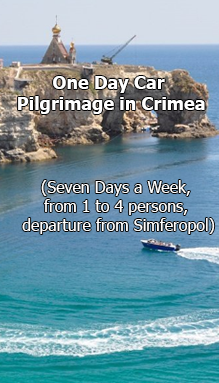St. Theodore Stratelates Cave Monastery “Ai-Todor” near the Village of Maloye Sadovoye (Chelter-Koba)
| Status: | active monastery | |
| Location: | In the Valley of the River Belbek, above the Village of Maloye Sadovoye | |
The Monastery history
In the Valley of the River Belbek above the Village of Maloye Sadovoye there tower three rocky capes. On the eastern Cape Kule-Burun (the Tower Cape) there is the Suirenskaya Fortress. There are preserved such its constructions as part of the defensive wall and the tower, erected approximately in VIII century. They suppose that on the second floor of the tower later the church was made. It was painted with frescos, from which there are preserved only fragments.
To the left from the fortification, in the precipice of the Cape Ai-Todor in the Middle Ages a small monastery appeared. Adjacency with the fortress is not accidental, nearby there was the northern boundary of the Princedom of Pheodoro, which was defended by the Suirenskaya Fortress. Behind its solid walls in case of danger the residents of the neighboring villages and monks could hide.
The Monastery was founded by the iconodules in VIII–IX century and existed to 1475, until the Turkish Army invaded into Crimea and caught the Princedom of Pheodoro. The Monastery was named in the name of St. Theodore Stratelates, it is preserved in the name of the rock. There are 22 caves of different sizes and purpose here. These are monastic cells, some of them are quite small with low ceilings; warehouse caves, the steward’s rooms, big refectory hall and, the most important one, the cave temple. It is situated in a big natural grotto with the area of more than 150 sq. meters. The grotto has a rounded form, narrowing to the east and west. For the altar there was cut a special square hole, in the walls of which there are niches. A low altar barrier separated the apse from the other part of the temple. In the north-eastern part of the church there was a baptistery. Along the northern and southern walls there are benches, in the walls there are cut burial vaults, in the floor there are four graves, one of them is small, it may be a child’s one, five more graves are in the western part of the temple. Such number of the graves allows to think, that in the Monastery they buried not only monks, but also the defenders of the fortress. The number of the monks, who used to live in the Monastery, was a small one, only 14–16 people. That is why in the huge temple of Chelter-Koba there prayed both monks, and warriors of the Suirenskaya Fortress, and the inhabitants of the surrounding villages.
Usually the monasteries with refectories, to which Chelter-Koba is also referred, were especially respected, in their temples there were holy relics and other sacred objects. Such monasteries were visited by a large number of the pilgrims. In ancient times all the Monastery caves were connected with wooden stairs and passages, that is why the Tatars gave it the name of Chelter-Koba (“chelter” means “a grate”, “koba” — “a cave”).
If one walks farther along the edge of the precipice, one can see a long grotto, leading to the source with tasty and curative water.












